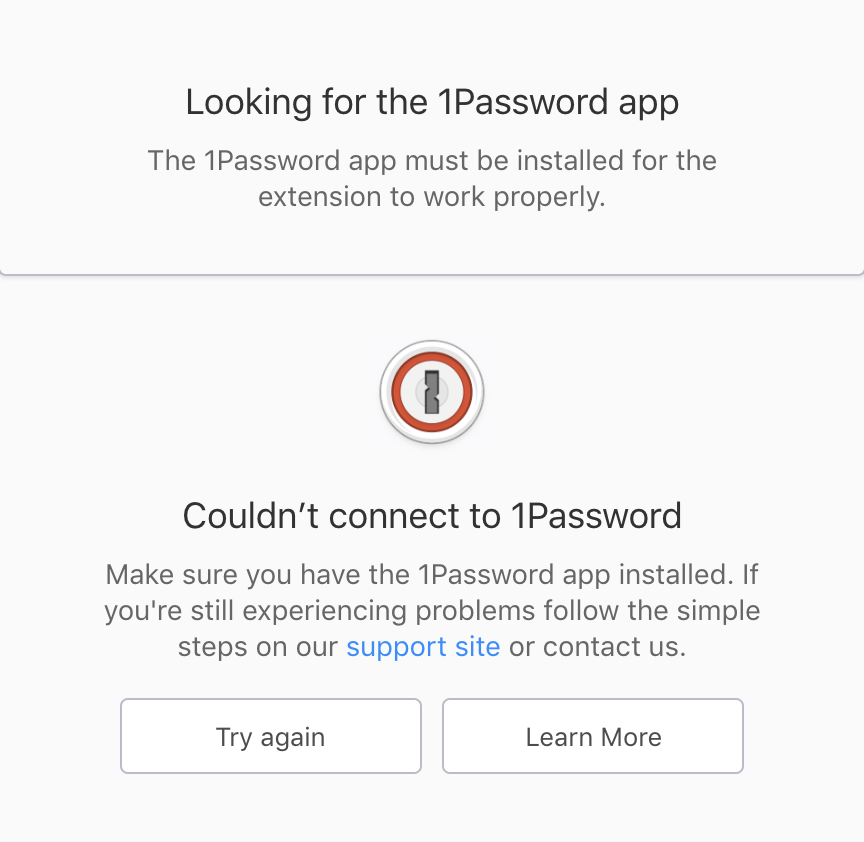The 1Password classic extension is no longer in development, so we’re unable to troubleshoot issues outside the scope of this article. Upgrade to the latest version of 1Password for Mac and switch to the improved 1Password browser extension for a more reliable experience.
About the message
1Password 6.8 for Mac introduced a more reliable method for saving and filling in browsers called native messaging.
Native messaging improves the performance and reliability of the 1Password classic extension, especially when proxies, antivirus, and other security software would otherwise interfere with 1Password. If 1Password is unable to detect support for native messaging in your browser, you’ll see this message.

What you should do
For all browsers
First, try restarting your browser. If you’re still having trouble, follow these steps to allow 1Password to use native messaging in your browser:
Open Terminal, which is in the Utilities folder of your Applications folder.
Copy and paste the following command and press Return:
mkdir -p ~/Library/Application\ Support/Google/ChromeOpen 1Password. Hold down the Control and Option keys on your keyboard and choose 1Password > Quit 1Password Completely from the menu bar.
Open 1Password again.
Restart your browser.
Follow the additional steps below if you use Brave, Vivaldi, or Chrome Canary.
If you use Brave
If you use Brave, make sure you’re using Brave 0.17.19 or later. Earlier versions do not have support for native messaging.
Using 1Password in Brave requires 1Password 7 or later.
If you use Vivaldi
If you use Vivaldi, make sure you’re using Vivaldi 1.11.917.43 or later. Earlier versions do not have support for native messaging.
If you use Chrome Canary or Microsoft Edge
If you use Chrome Canary or Microsoft Edge, follow these steps to allow 1Password to use native messaging in your browser:
Make sure the 1Password app and your browser are both in the Applications folder.
In Finder, choose Go > Go to Folder. Copy and paste the following path and press Return:
~/Library/Application Support/Google/Chrome/NativeMessagingHosts/Look for a file named
com.1password.1password7.json,com.1password.1password.json, or2bua8c4s2c.com.agilebits.1password.jsonand copy it to your desktop.If you see more than one of these files, copy all the relevant files to your desktop.
Choose Go > Go to Folder. Copy and paste the correct path for your browser and press Return:
- Google Chrome Beta:
~/Library/Application Support/Google/Chrome Beta/ - Google Chrome Dev:
~/Library/Application Support/Google/Chrome Dev/ - Google Chrome Canary:
~/Library/Application Support/Google/Chrome Canary/ - Microsoft Edge Beta:
~/Library/Application Support/Microsoft Edge Beta/ - Microsoft Edge Dev:
~/Library/Application Support/Microsoft Edge Dev/ - Microsoft Edge Canary:
~/Library/Application Support/Microsoft Edge Canary/
- Google Chrome Beta:
Open the folder
NativeMessagingHostsor create it if it doesn’t exist.Drag the file named
com.1password.1password7.json,com.1password.1password.json, or2bua8c4s2c.com.agilebits.1password.jsonfrom your desktop into theNativeMessagingHostsfolder.If you copied more than one of these files to your desktop, drag all the files into the
NativeMessagingHostsfolder.Restart your browser.
Get more help
If you’re still having trouble:
- Create a diagnostics report on your Mac.
- Contact 1Password Support with a description of the problem and attach the diagnostics report that you created.